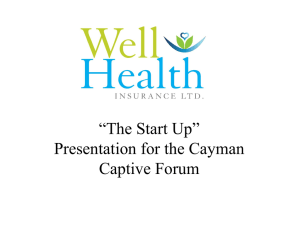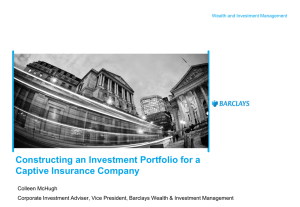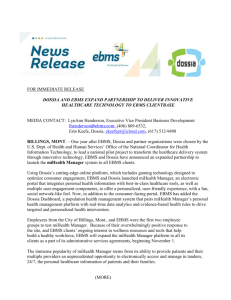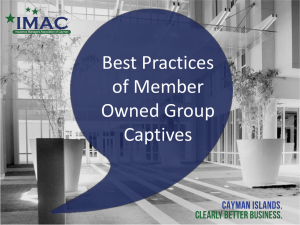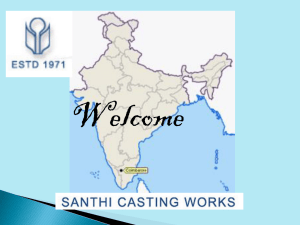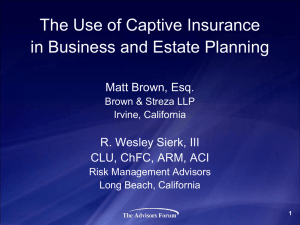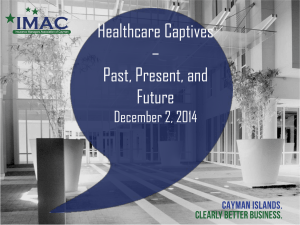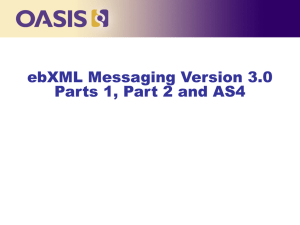EBMS - Western Region Captive Insurance Conference
advertisement
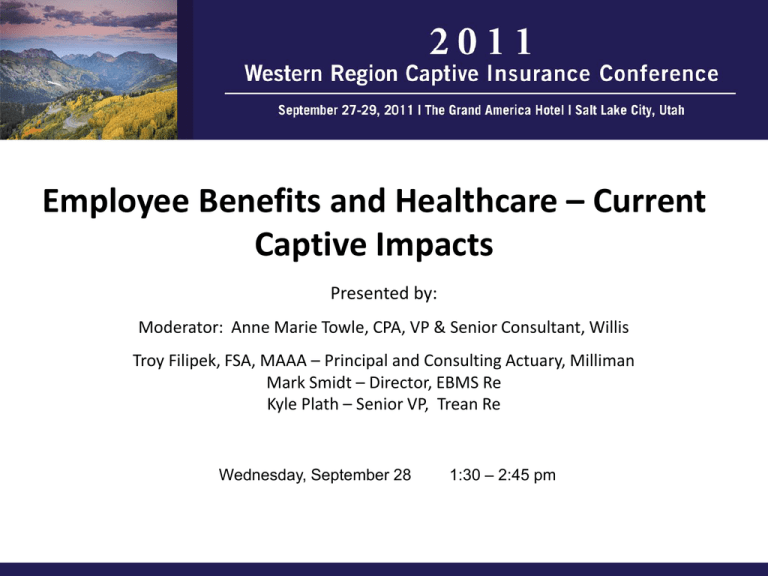
Employee Benefits and Healthcare – Current Captive Impacts Presented by: Moderator: Anne Marie Towle, CPA, VP & Senior Consultant, Willis Troy Filipek, FSA, MAAA – Principal and Consulting Actuary, Milliman Mark Smidt – Director, EBMS Re Kyle Plath – Senior VP, Trean Re Wednesday, September 28 1:30 – 2:45 pm Agenda • • • • Healthcare Captives – Why and how? Impact of Healthcare Reform (PPACA) Case Study – EBMS and Trean Re Discussion and Questions Healthcare Captives • Why Captives for Healthcare? Similar as for other lines of business . . . – Reduced insurance expenses – Possible tax efficiencies – Cash flow management – More efficient use of capital (i.e., float) – Ability to develop custom insurance programs – more flexible than commercial market Healthcare Captives • But healthcare is also different . . . – Short term vs long tail expenses – Generally predictable claim patterns – Uncorrelated exposures relative to traditional risks held in captives – PPACA pressures Healthcare Funding • Three types of funding mechanisms traditionally – Fully insured – All risk transferred through premiums – Self insured – All risk retained; use health plan to access network and pay claims – Hybrid – Self insure with stop loss (aggregate and/or specific) to transfer catastrophic risk • Stop Loss – Specific – Per person catastrophic – Aggregate – Total employer costs Option 1: Jumbo Employers • Works for sponsors with > 10,000 ees • Huge advantage to already have a captive in place that insures other uncorrelated risks • Option 1a - Medical stop loss coverage only – Generally includes steep risk margin in commercial market – More later in case study • Option 1b – Reinsure ERISA benefits (e.g., group life, disability, AD&D) – Employer acts as reinsurer and needs Prohibited Transaction Exemption (PTE) – Administrative and regulatory requirements big • Results – Lower costs for same protection – More premium and spread of risk in captive Option 1: Jumbo Employers • Administrative and Regulatory Issues – DOL must approve PTE under Option 1b since ERISA prohibits economic gains from providing benefits • Need A-rated fronting insurer per DOL • Need competitive rates and year 1 benefit enhancement – Capital and surplus requirements – Need competencies in running captive – Beware NAIC tightening of stop loss model law – Forces employers of all sizes to retain larger portion of risk Option 1: Jumbo Employers • PTE Process (Option 1b) – Conduct feasibility study (cost/benefit analysis) – Get help fast • Captive manager • Attorneys • Independent fiduciary – Opine on PTE compliance – US branch approval – domiciled jurisdiction if not a US captive – Negotiate contract with A rated fronting insurance company – File for PTE with the DOL and implement plan Option 2: Smaller Employers • See some sponsors with < 100 ees push to self funding under PPACA • Pool together risks across employers • Hybrid funding noted earlier – stop loss through captive • Historically, RRGs used to get around state licensure requirements, but state lawsuits slowed this trend • Employer specific self funded plan, attachment point, pricing, etc. • Results – Lower costs than fully insured – Lower costs than commercial stop loss PPACA Influence • PPACA – Health Insurance Reform • Costs continue to rise and many fear PPACA makes it worse • New issues and concerns – – – – No annual or lifetime benefit maximums New mandates (e.g., $0 preventive with expanding definition) New entities – Exchanges, Co-ops, Accountable Care Organization, etc. New regulations (e.g., no medical underwriting, minimum loss ratios) and fees (e.g., insurer fees) PPACA Influence • Employers - Much more interest in self-insuring to: – Avoid community rating for groups with better than average risks – Avoid fees imposed on fully insured plans – Avoid benefit mandates – Take advantage of new offerings from savvy brokers and carriers PPACA Influence • Other entities – Provider groups / ACOs: Historical management of financial risk did not go well, consider other options with financial risk coming back – Co-ops: Not for profits established to compete with insurers, likely will need help with risk management / transfer / funding Using Captives to Smooth Out Using Captives to Smooth Out Medical Stop-Loss Insurance Expense Medical Stop-Loss Insurance Expense Mark Smidt – Director of EBMS Re Kyle Plath – Senior VP of Trean Re Time-Frame EBMS Entered the Stop-loss Arena – 1999-2000 • Significant Cost Adjustments from Stop-loss Insurance Markets – Stop-loss Carrier’s Actions to Correct Soft-Pricing Included: • Lasers • Steep Renewal Increases • Non-Renewals Objectives of EBMS’ Captive Program • Stabilize Stop-loss Insurance cost through: – Eliminating lasering and non-renewals – Pooling the risk • Renewals based on actuarial models, not individual experience rating = effectively eliminating spikes – – – – – – Profit sharing – achieved thru renewal discounts (Premium Discounts) Create efficiencies by eliminating duplications of efforts Specific Reimbursement turnaround times – reimbursement authority Renewals able to be “locked-in” based on 10 months of experience Create a “partnership” atmosphere for clients – Annual “Advisory Meeting” Access to underwriting staff Captive’s Risk Layer $300,000 $250,000 $200,000 $150,000 $100,000 $50,000 $2002 2003 2004 2005 2006 2007 2008 2009 2010 2011 “Leverage Trend” offset at the Captive’s risk layer 2002 = 150k multiplied by 10.5% (8) = 368k Current Specific Risk Assignment XS Reinsurance $Unlimited xs $20M XS Reinsurance $10M xs $10M XS Reinsurance $5M xs $5M XS Reinsurance $3M xs $2M XS Reinsurance $1M xs $1M XS Reinsurance Risk Layer - Up to $1million xs of EBMS Re’s Retention EBMS Re’s Risk Layer - First $300K above SIR Plan Sponsor's Risk Layer = Spec Deductible/SIR Gross Premium by Underwriting Year (Millions) $14.00 $11.53 $11.44 $11.39 $12.06 $12.00 $9.73 $10.00 $8.38 $8.00 $5.79 $6.00 $4.34 $4.00 $2.92 $2.00 $0.00 2002 2003 2004 2005 2006 2007 2008 2009 2010* ESTIMATED Average Specific Deductible by UY (Weighted by Employee Lives) $350,000 $300,000 $250,000 $200,000 $150,000 $100,000 $50,000 $2002 2003 2004 2005 2006 2007 2008 2009 2010 Premium Credit Triangle – Block Calendar Year: 2002 2003 2004 2005 2006 2007 2008 2009 2010 2011 Client’s % of Total Prem 100% 100% 100% 100% 100% 100% 100% 100% 100% 100% UY 2002: Maturity Period 30% 15% 15% 15% 5% 20% Final Adjustment 30% 15% 15% 15% 5% 20% Final Adjustment Maturity Period 30% 15% 15% 15% 5% 20% Maturity Period 30% 15% 15% 15% 5% 30% 15% 15% 15% Maturity Period 30% 15% 15% 30% 15% UY 2003: Maturity Period UY 2004: UY 2005: UY 2006: Maturity Period UY 2007: UY 2008: Maturity Period UY 2009: Maturity Period 30% 2002 to 2009 Combined Allocation of Income (Inception to Date) Program Flow Chart Benefit Plan Stop Loss Policy EBMS Stop-Loss Administrator Administration Agreement Premium Discounts Net Results EBMS Re “Pooled” EBMS Captive (Reinsurer) Issuing Carrier Stop-Loss Carrier Excess of Loss Reinsurance Contract Excess- Loss Reinsurer Quota Share Reinsurance Contract Considerations in Forming a Captive • Domicile – EBMS originally selected Cayman Islands and redomesticated to Montana • Captive Structure – EBMS originally formed as a single cell captive and has transitioned to a segregated cell structure in Montana Considerations in Forming a Captive • Capitalization and Ownership – EBMS chose to fund the start-up capital and maintain 100% ownership of the captive • Risk Structure – EBMS purchased Specific Excess Reinsurance from the inception of the program, increasing its retention as the premium volume has grown EBMS Re’s Structure Issuing Carrier – Excess Loss Carrier (or Issuing Carrier) on the program – Has given the Captive the authority to underwrite and issue stop-loss policies in their behalf – Maintains the necessary ratings and licensures for the captive to operate. – Contracting body for the program’s reinsurance carriers & ensures the financial integrity of the entire program EBMS Captive – Quota Share reinsurance company on the program as well as the underwriting body Professional Reinsurer – Provides Excess Loss reinsurance coverage for the program …cont. EBMS Re’s Structure Trean Reinsurance Services – Program’s Reinsurance Intermediary. Facilitates the “marriage” of all the carriers and reinsurers associated with the program EBMS – Staffing support in: underwriting, policy issuance, administrative support, claim auditing, management, marketing – Capital Investment Questions???

